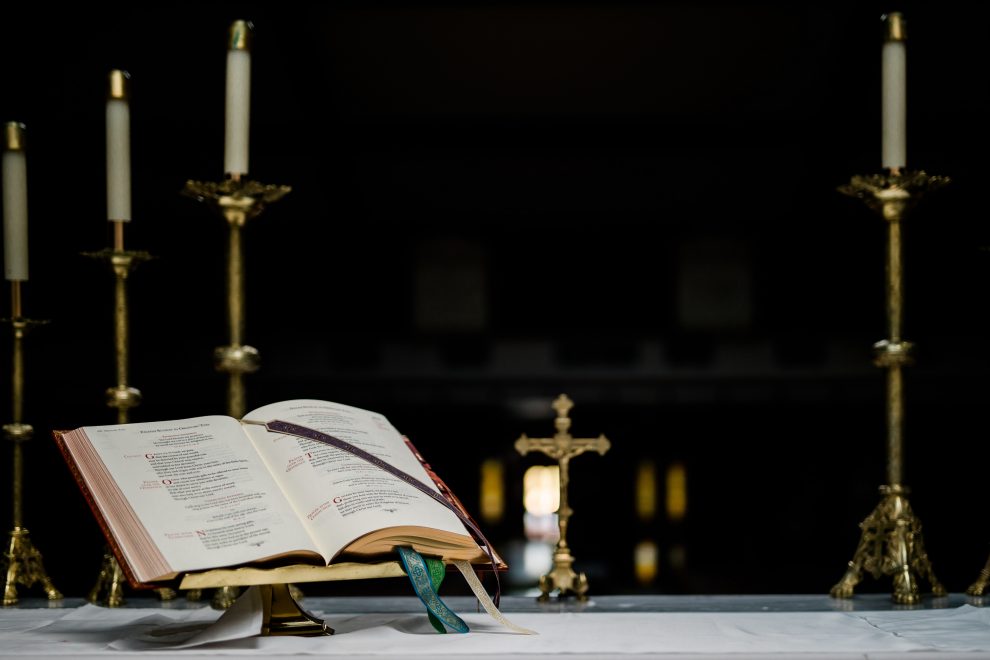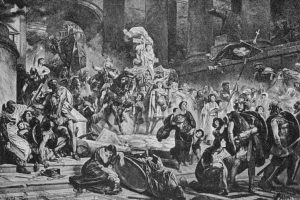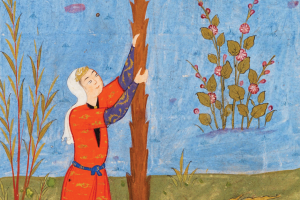If any scholar could claim a ring-side seat to the liturgical reform of the 20th century, it would have to be Father Robert Taft, S.J. Taft recalls being surprised when he arrived in Europe in 1964 to see liturgical change already well underway. “Worker priests in Western Europe were celebrating the liturgy in the vernacular because it was the only way to come into contact with the de-Christianized workers there,” he says. “The notion of celebrating the liturgy for them in Latin was simply absurd.”
A Jesuit ordained in the Russian rite of the Byzantine Catholic Church in 1963, Taft eventually focused his studies on the ancient liturgies of the Christian East, work that has led him to a profound appreciation of the diversity of Christian liturgy in the past and present. “There is no ideal form of the liturgy from the past that must be imitated,” he says. “Liturgy has always changed.” Tracking those changes has been his life’s work, a career that has included decades of teaching all over the world as well as hundreds of books and articles.
Though a historian, Taft is critical of attempts to remain in the liturgical past in the name of tradition. “We don’t study the past in order to imitate it,” he says. “Tradition is not the past. Tradition is the life of the church today in dynamic continuity with all that has come before. The past is dead, but tradition is alive, tradition is now.”
Forty years after the Second Vatican Council, there is still argument about its liturgical reform. What do you make of the continuing opposition to the “new” liturgy?
Let me put my cards right on the table: I’m a Vatican II loyalist without apologies to anyone. The Second Vatican Council was a general council of the Catholic Church, and the popes since the council have made it clear that there’s no going back. The mandate for liturgical reform was passed by the council with an overwhelming majority, so it is the tradition of the Catholic Church, like it or lump it.
Unfortunately, partly as a result of the schism of the late Archbishop Marcel Lefebvre and his followers, there has been an attempt on the part of a group of what I call “neo-cons” to portray the reforms of Vatican II as something that was foisted upon the church by a small minority of professionals contrary to the will of many people in the church. This is what we know in the vernacular as slander.
The reforms of the council were carried out under Pope Paul VI in a spirit of complete collegiality. Every suggested adaptation, change, or modification was sent out to every Catholic bishop in the world, and the responses that came in were treated with the utmost respect. When changes were severely questioned or opposed by a large number of bishops, they were revised according to the will of the bishops and then sent back again.
So the notion that the liturgical reform was somehow forced on an unknowing church by some group of “liturgists,” as if that were a dirty word, is a lie, and that needs to be said.
So the reform didn’t come out of nowhere?
The pastoral liturgical movement began in the 19th century as an attempt to get the people not to pray at the liturgy but to pray the liturgy. People were at the Eucharist, but they were praying the rosary or reading a prayer book or something. You had two things going on at once. The whole point of the reform was to allow people to be active participants in the liturgy, as Pope Pius XII himself insisted in his encyclical Mediator Dei (On the Sacred Liturgy) in 1947, well before Vatican II.
What we sometimes forget is that it wasn’t the Second Vatican Council that began the reforms of the liturgy. It was Pope St. Pius X, who in 1910 reduced the age of First Communion to the age of reason and, in perhaps the most successful liturgical reform in the history of the church, restored the Eucharist as the daily food of the people.
People who don’t know any history don’t understand that this was a very long process. When I was a kid, pastors did everything they could to get people to go to Communion on Sunday. They had Men’s Sunday, Women’s Sunday, Family Sunday, Knights of Columbus Sunday-whatever they could do to get people to go to Communion at least once a month.
Now the vast majority of people go to Communion at every single liturgy-a great success that turned around centuries of history in which people used to go at the most once or maybe four times a year.
It didn’t end there. Pope Pius XII restored the celebration of the Easter Vigil in 1951, which took the world by storm, followed by all the liturgies of Holy Week in 1955.
People who complain about the Second Vatican Council forget where it began and how long it took and how long the church prepared for it. The notion that it was done in a rush and shoved down the church’s throat is simply ridiculous.
What about the oft-mentioned liturgical “abuses”?
After Vatican II some people unfortunately thought that they had to be creative. As I’ve said more than once, I have never understood why people who have never manifested the slightest creativity in any other aspect of their human existence all of the sudden think they’re Shakespeare or Mozart when it comes to the liturgy. That’s sheer arrogance.
Certainly there were abuses, but the abuses weren’t the responsibility of the council’s reforms. In part as a result of the church’s resistance to the Protestant Reformation, Rome refused even very positive suggestions that were part of it, for example, returning the chalice to the people. This in effect put the Catholic liturgy in the freezer for centuries.
When the ice melted after Vatican II, things overflowed and people thought that they could do what they wanted with the liturgy. I can remember some of those “howdy-doody” liturgies. But let’s put the responsibility where it belongs.
Everything has its downside, and one of the downsides of the reform was that people were ready to burst.
How has the liturgical reform been a success?
The best thing about it is that people have come once again to pray the prayer of the church rather than praying during it, which is, without any doubt, the result of celebrating the liturgy in the vernacular.
When I was a kid, the gospel and epistle readings were proclaimed in Latin and then sometimes the gospel might be repeated in English. Who were we reading them for, God? God knows all the languages already. The prayers of the liturgy are for us.
Now Catholic communities throughout the world participate in the liturgy actively and interiorly, praying the prayers of the liturgy, giving the responses, singing the hymns, paying attention to the readings, and so forth. The Liturgy of the Hours, especially Morning and Evening Prayer, has been restored in parish worship in many countries. This is part of the prayer of the church, too.
The restoration of the Rite of Christian Initiation for Adults has been a marvelous success for activating entire parishes to cooperate in bringing new candidates into the church. A pastor in Washington, D.C. wrote a beautiful article in the liturgical journal Worship describing how the RCIA had transformed the entire life of his parish, with the people themselves bringing the candidates into the bosom of the church through catechesis, prayer, the exorcisms, and so forth, until they reach Baptism.
The reform has been an enormous success, and if you can’t see this, then you must be blind.
What are the arguments of those who still oppose the reforms?
Some complain that Vatican II’s reform wasn’t done by the council but by post-conciliar commissions, but the same is true of the liturgical reform of the Council of Trent. Trent, like Vatican II, left it to the pope at the time, Pius V, to implement changes in the liturgy. He naturally appointed others to do the actual work.
Why aren’t they complaining about the way things were done at the Council of Trent? This is all foolishness as far as I’m concerned, foolishness of people who don’t really know the true story.
When Pope John Paul II canvassed the Catholic hierarchy concerning the desire for the pre-Vatican II liturgy early in his pontificate, less than 1.5 percent of the bishops said that their priests and people were in favor of it, so there was no great outcry for its return. The rest of the episcopate said to leave it alone.
For his own good reasons, Pope John Paul decided to permit the continued use of the old rite, and the present pope has extended it to win back these so-called “traditionalists.”
But the real problem isn’t the liturgy, it’s that people, including the Lefebvrites, don’t accept the teaching of the Second Vatican Council, which is the teaching of the Catholic Church. They believe that the Second Vatican Council taught error. They believe that Pope Paul VI was not a real pope.
How can you pretend to be Catholic if that’s your point of view? I’m not attempting to force anybody to be Catholic, but let’s stop this pretense.
What about those who claim that the old liturgy is more “mysterious” or reverent than the new? Are they right?
Absolutely not. The mystery we’re trying to celebrate in liturgy is the fact that Jesus Christ died and rose for our salvation, and we have died and risen through Baptism to new life in him.
That life is expressed in the liturgy. It is nourished through scripture and the Eucharist and prayer. You don’t need Latin for that.
Some people think liturgy is our gift to God. If we go to church on Sunday, we’re doing God a real big favor.
But our liturgy is God’s gift to us, not ours to him. St. Paul is quite clear that the purpose of the liturgy is not what we do at the celebration itself. That is simply the expression and nourishment of what is supposed to be the “liturgy of life,” the way we live in the world.
That’s why St. Paul never uses words such as sacrifice, priesthood, or worship except to describe the life we live after the model of Christ. “It is not I who live,” he writes, “but Christ who lives in me.” That’s the mystery the liturgy is all about.
Do you think people make the connection?
Most people don’t realize it, of course, because they don’t spend any time thinking about it. That’s why we have preaching.
The preacher should make them think about it. The preacher should wake them up. The preacher should catch their attention by saying something that has meaning for them and their lives today. That’s why one of the most important aspects of preparation for Sunday on the part of the pastor should be his prayer and meditation on the readings.
It’s not easy, but it can be done. It’s done at the beginning of the week, reading and praying over the scriptures, meditating on them. I always read very carefully the texts of the refrains and prayers of the liturgy as well. But, to put it bluntly, it takes that four-letter word, work.
Beyond that the preacher has to open up the meaning of the liturgy itself. Sometimes people will come into the sacristy and ask, “What are you offering the Mass for today, Father?” I always answer: “Open the book, it’s all right there. I didn’t make it up.”
Just read the prayers. They say what we are doing in Baptism, what we are doing in Matrimony. People think Matrimony is a ritual expression of the love between a man and a woman. Baloney. You can do that at City Hall.
What’s the difference?
A Christian marriage should be about what Jesus Christ’s death and Resurrection has to do with marriage.
What does Christ tell us through St. Paul in Ephesians? Ephesians says Christian marriage is like the union between Christ and the church, a permanent union, a union of love, a union of shared life.
It’s not about the love of a man and a woman; it’s about the love of a man and a woman in the context of the fact that Jesus Christ died and rose for our salvation.
Liturgy is the expression of where we’re supposed to be, not something that we drag down to where we’re at. Liturgy is the ideal to which we must rise. Liturgy is the model of a life given for others rather than life lived for ourselves. The bread we break is the sign of a body broken for us, and the chalice we drink is the blood poured out for us. They are symbols of a life lived and given for others.
When we celebrate that reality in the liturgy, whether in Eucharist or Reconciliation or Matrimony, we’re saying: This is what we, with the grace of God, pledge that we’re trying to be. If it’s not, then we shouldn’t be there; we’re wasting our time.
How do you respond to the complaint that people don’t get anything out of the liturgy?
What you get out of the liturgy is the privilege of glorifying almighty God. If you think it’s about you, stay at home. It’s not about you. It is for you, but it’s not about you.
One of the great problems today, especially among some of the younger generations, is that they think that salvation history is their own autobiography. They think they’re the center of the universe. In John 3, when John the Baptist is asked whether Jesus is the Messiah, John says quite clearly that Jesus is the important one: “He must increase, I must decrease.”
He must increase, I must decrease. Everybody needs to hear that. It’s not about me, it’s not about you. It’s about something infinitely more important than us.
Why is it important that liturgy stay basically the same week to week?
People will never take possession of the liturgy as their own if every time the pastor reads a new article, the liturgy in the parish is turned on its head. Who does this liturgy belong to?
Catholics need to stop tinkering with the liturgy. They need to take it the way it is and celebrate it as well as possible. If they do that, the problems will disappear.
Take the kiss of peace, for example. Sometimes people don’t know if they’re going to get kissed or jumped. I always tell my students that it’s the “kiss of peace,” not “a kiss apiece.”
The kiss of peace is a ritual gesture. What does that mean? That means it’s a formalized gesture that carries its own meaning.
The kiss of peace is not an expression of your friendship with whomever is standing around you, and you don’t have to crawl over three pews to get to somebody you know. It is shared among people in your immediate vicinity as a sign that we’re in the same boat together. The same thing is true of things such as the traditional greetings and so forth.
Is there any place for creativity in the liturgy?
The two places that the church has left to our creativity, the homily and the prayers of intercession following the readings, are the two places where our liturgies are generally irredeemably awful. If you want to be creative, devote your creativity to the places where the liturgy allows it.
I’m not preaching against future liturgical change. Liturgies evolve normally, like languages do. They acquire new words and so forth.
People today say, “That’s cool.” Cool when I was a kid meant that something just came out of the fridge. So words acquire new meanings.
But it’s not the work of individuals. It’s not up to me to say I’ll use the word window for door and door for window, because that’s where I’m at today. If we do that with language, people won’t understand what we’re talking about.
The same thing is true of liturgy. Leave it alone and it will grow by itself, but don’t stand it on its head every Sunday, because people are sick of that.
Some people would like the liturgy to be the same everywhere, as it was before Vatican II. Is that what we should be shooting for?
It was never the same everywhere, unless you wish, as some Catholics would, to limit the boundaries of Christ’s church to the Roman rite and exclude the liturgies of the Eastern Catholic Churches, which would be sheer foolishness.
The church is a great mosaic of different traditions, of different peoples. Until the life of the church has reached expression in every single culture, there will still be something lacking. St. Paul said we have to fill up what is lacking in the Body of Christ.
What’s lacking in the Body of Christ is not anything about God; it’s about us. In other words, until the whole of humanity has become completely conformed to the mystery of Christ, then there’s something lacking.
To fill up that lack, we need to have Vietnamese and Chinese and African and Indian expressions of that reality. The sacraments remain the same, the faith remains the same, but they take on different expressions that can all be valid. So there’s still a lot of work to be done.
What is the biggest liturgical abuse out there?
If you want a very concrete example, anybody who knows anything about eucharistic theology—and that’s a very small minority—knows that there’s a single movement in the Eucharist. The community offers its gifts through the hands of the priest to God, which God accepts and returns to us as his gift to us, the Body and Blood of his Son.
That’s why Pope Benedict XIV in the 18th century, Pope Pius XII in the mid-20th, Pope Paul VI, and every single liturgical document that’s come out since Vatican II have said that the people should receive the Eucharist from the gifts consecrated at the liturgy they attend, not from the tabernacle.
But what do you see in the United States in practically any parish church? A half-dozen hosts are consecrated, and then the priest is running up to the tabernacle. Three popes and every single document on the liturgy have said to stop it: The people have a right to receive hosts consecrated at the liturgy that they celebrate, because the whole community celebrates the liturgy through the voice of the church’s representative, the priest.
What difference does it make if people still receive Communion?
Liturgy is symbol. That doesn’t mean it’s not real. One of the dumbest ideas in the world was invented in the ninth century when someone came up with the notion that something was either symbolic or real. The Eucharist is both symbolic and real. The presence of Jesus Christ in the consecrated bread is obviously symbolic, otherwise you’d see ears and eyes and a nose. That’s a no-brainer. But to say something is symbolic doesn’t mean that it’s not real.
To serve people the Eucharist from hosts consecrated at a previous Mass is like inviting people to a banquet, cooking the meal, and then having the cook sit down and eat it while everyone else gets what’s left in the fridge from yesterday. Everybody gets fed, nobody starves, but the whole symbol of a common offering and a common reception of the common gifts is totally destroyed.
The purpose of the Mass isn’t to make hosts so people can go to Communion. The purpose of the Eucharist isn’t to change bread and wine into Jesus Christ. It’s to change you and me into Jesus Christ. That is not only supposed to happen, it’s also supposed to be represented.
Is Communion from the tabernacle valid? Is Jesus really there? Of course he is. That’s not the point. We are talking about the entire movement of a celebration in which we bring the gifts that represent our gift of ourselves to God.
God’s acceptance of and return to us of those very same gifts are part of the single movement of the Eucharist. Anybody who doesn’t know that doesn’t have any idea what the Mass is.
This interview was conducted by Bryan Cones during the annual conference of the Notre Dame Center for Liturgy in June.
This article appeared in the December 2009 issue of U.S. Catholic (Vol. 74, No. 12, pages 26-30).
Image: Grant Whitty on Unsplash













Add comment